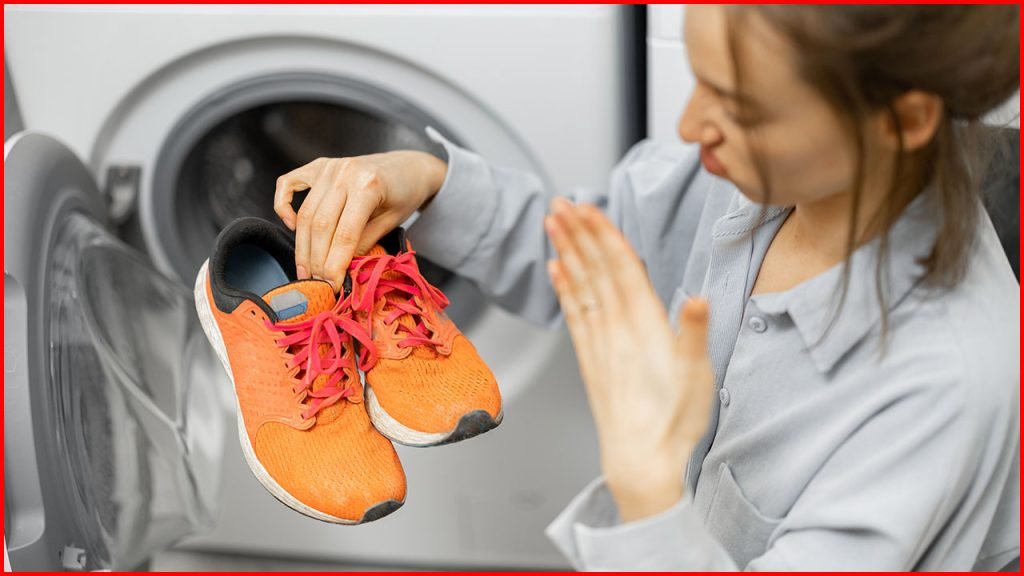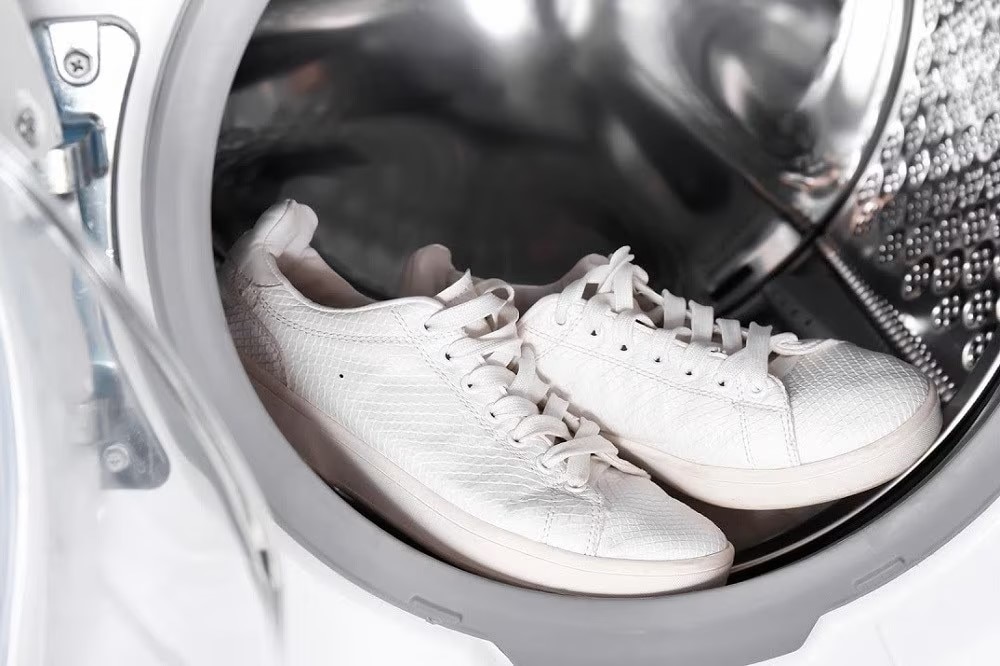To wash shoes in a washing machine without a mesh bag, remove the laces and insoles, place the shoes in a pillowcase, and secure it with a knot or rubber band. When it comes to keeping our shoes clean and fresh, it can be a challenge to find the right method.
While some may prefer handwashing, others wonder if tossing their shoes in the washing machine is a viable option. If you’re looking for a convenient way to clean your shoes without using a mesh bag, you’re in luck. We will share a simple technique that allows you to wash your shoes in a washing machine without the need for a mesh bag.
So, without further ado, let’s dive into the steps you need to follow to get your shoes looking good as new.
Table of contents
How To Wash Shoes Without A Mesh Bag: A Pro’s Technique
Washing shoes in a washing machine is a convenient way to keep them clean and fresh. However, you might have heard that using a mesh bag is necessary to protect them during the wash.
With our step-by-step instructions, you can effectively clean your shoes in the washing machine without worrying about damaging them.

Why Using A Mesh Bag For Washing Shoes Is Not Necessary
Contrary to popular belief, using a mesh bag is not essential when washing shoes in the washing machine. While a mesh bag can provide an extra layer of protection, it is not the only method to prevent damage. In fact, using a mesh bag has its disadvantages.
First, it may impede the cleaning process as it can limit the water and detergent’s access to your shoes.
Second, depending on the type of mesh bag, the openings may be too large for smaller shoes or too small for larger shoes, causing an uneven wash.
How To Prepare Your Shoes For The Washing Machine
Before tossing your shoes in the washing machine, it’s important to prepare them adequately. Here’s what you need to do:
- Remove any loose dirt or debris from the shoes by gently brushing them with a soft brush or wiping them with a damp cloth.
- Untie shoelaces or remove any removable parts like insoles or inserts.
- If your shoes are particularly dirty, pre-treat stains by applying a small amount of gentle detergent directly to the affected areas and gently rubbing it in with a soft brush or cloth.
Step-by-step Instructions For Washing Shoes Successfully
Now that your shoes are prepped, it’s time to wash them in the machine. Follow these step-by-step instructions:
- Place your shoes inside a pillowcase or wrap them in a towel. This will provide an additional layer of protection during the wash.
- Prepare the washing machine by ensuring there are no other items inside and selecting a delicate or gentle cycle. Set the water temperature to cold or lukewarm to prevent any possible shrinkage or damage.
- Add a small amount of mild detergent to the washing machine. Avoid using bleaches, harsh chemicals, or fabric softeners, as they can damage the material of your shoes.
- Start the washing machine and let it complete the cycle. Be sure to stay nearby in case any adjustments or interventions are needed during the wash.
- Once the cycle is complete, take your shoes out of the pillowcase or towel and inspect them for any remaining dirt or detergent.
- If necessary, dampen a clean cloth or sponge and wipe off any remaining residue from your shoes.
Following these steps will ensure that your shoes are effectively cleaned without the need for a mesh bag. Remember to let your shoes air dry naturally, away from direct heat or sunlight, for optimal results. Enjoy your freshly cleaned shoes!
Check The Label: Shoe Material And Machine Suitability
One of the most important steps before tossing your shoes into the washing machine is to check the label for important information about the shoe’s material and whether it is suitable for machine washing. This simple step can prevent damage to your shoes and ensure that they come out clean and fresh without losing their shape or color.
Importance Of Identifying The Material Of Your Shoes
Knowing the material of your shoes is crucial when it comes to determining whether they can withstand the rigors of machine washing. Different materials react differently to water, agitation, and detergents.
Washing shoes made from delicate materials such as suede or leather in a washing machine can lead to irreparable damage, ruining both the appearance and durability of the shoes. On the other hand, shoes made from sturdier materials like canvas or synthetic fabrics might be more suitable for machine washing.
Which Shoe Materials Are Suitable For Machine Washing
Not all shoe materials are meant to be machine washed. Here is a breakdown of commonly found shoe materials and their suitability for machine washing:
Shoe Material | Suitability for Machine Washing |
|---|---|
Canvas | Generally safe for machine washing. Check specific care instructions. |
Nylon/Mesh | Usually safe for machine washing. Check specific care instructions. |
Rubber | Safe for machine washing. Check for any detachable parts. |
Plastic | Safe for machine washing. Check for any detachable parts. |
Leather | Generally not suitable for machine washing. Use alternative cleaning methods. |
Suede | Usually not suitable for machine washing. Use alternative cleaning methods. |
How To Determine If Your Shoes Can Be Safely Washed In A Washing Machine
While checking the shoe material is important, you should also consider factors like construction, decorations, and vulnerability to water damage. Here’s how to determine if your shoes can be safely washed in a washing machine:
- Refer to the shoe’s care label: Look for specific instructions regarding machine washing. If the label states “hand wash only” or “do not machine wash,” it’s best to follow those instructions.
- Inspect any decorative elements: If your shoes have delicate embellishments, such as sequins or beads, machine washing may cause them to come loose or get damaged. Consider hand-washing or spot-cleaning in such cases.
- Check for detachable parts: Some shoes have detachable insoles or liners. If these parts can be removed, take them out before washing to prevent damage and ensure a thorough clean.
- Consider the shoe’s overall condition: If your shoes are already in poor condition, with loose seams or weakened glue, machine washing can exacerbate these issues. In such cases, it’s better to opt for manual cleaning methods.
By carefully considering the shoe material, construction, and any specific care instructions provided, you can confidently determine if your shoes are suitable for machine washing. Caring for your shoes properly will not only extend their lifespan but also keep them looking their best, so don’t skip this important step before tossing them in the wash.
Pre-treatment: Removing Dirt And Stains
Before tossing your beloved shoes into the washing machine, it’s crucial to pre-treat them and remove any dirt or stains. By taking this extra step, you can ensure that your shoes come out looking fresh and clean without any leftover grime. In this section, we’ll explore the importance of pre-treating shoes before washing, effective methods to remove dirt and stains from different types of shoes, as well as some valuable tips and tricks to tackle stubborn stains.
Importance Of Pre-treating Shoes Before Washing
Pre-treating your shoes before washing is essential to achieve optimal results. This step helps to loosen up dirt and stain particles, making them easier to remove during the washing process. Additionally, pre-treating allows you to target specific areas that require extra attention, ensuring a thorough cleaning. By investing a little time in pre-treating, you can safeguard the condition and longevity of your beloved shoes.
How To Remove Dirt And Stains From Different Types Of Shoes Effectively
Removing dirt and stains from different types of shoes requires a tailored approach. Here’s a rundown of effective methods for various shoe materials:
Shoe Material | Effective Cleaning Method |
|---|---|
Canvas or fabric | Gently brush off loose dirt and use a mild detergent solution or stain remover to treat stains. |
Leather or suede | Wipe off surface dirt with a soft cloth, then use a specialized leather cleaner or suede brush to tackle stains. |
Mesh or knit | Remove loose dirt by tapping shoes together, and use a soft brush along with soapy water to eliminate stubborn stains. |
Tips And Tricks For Stubborn Stains
Dealing with stubborn stains on your shoes? Here are some tried-and-true tips and tricks to tackle them:
- For tough stains on canvas or fabric shoes, create a paste of baking soda and water, apply it to the stained area, and let it sit for a few minutes. Then, scrub it off gently with a soft brush and rinse with water.
- If your leather or suede shoes have stubborn stains, try using a vinegar and water solution. Dampen a cloth with this mixture and gently dab at the stain. Be sure to test it on a small, inconspicuous area first.
- When dealing with mesh or knit shoes, an effective solution for stubborn stains is to apply a mixture of hydrogen peroxide and water to the affected area. Let it sit for a while, then rinse thoroughly.
- Remember to always air dry your shoes after washing them, as machine drying can cause damage to certain materials. Stuffing them with newspaper can help speed up the drying process and maintain their shape.
Selecting The Right Detergent And Settings
When it comes to washing your shoes in a washing machine, it’s important to choose the right detergent and settings to ensure a thorough and effective clean.
Types Of Detergents Suitable For Washing Shoes
Before tossing your shoes into the washing machine, it’s crucial to select a detergent that is suitable for cleaning shoes. The type of detergent you choose will depend on the material of your shoes and the level of dirt or stains you need to tackle. Here are a few options to consider:
Detergent Type | Suitable Materials | Benefits |
|---|---|---|
Regular Laundry Detergent | Cotton, canvas, sneakers |
|
Mild Detergent | Delicate fabrics, leather, suede |
|
Sport Shoe Cleaner | Athletic shoes, performance materials |
|
Choose Appropriate Settings For Shoe Washing
In addition to selecting the right detergent, it’s equally important to choose the appropriate washing machine settings for washing your shoes. Here are a few key considerations:
- Gentle or Delicate Cycle: To avoid damaging the shoes, opt for the gentle or delicate cycle on your washing machine. This setting minimizes agitation and ensures a more careful cleaning process.
- Cold Water: Cold water is the preferred temperature when washing shoes as it helps preserve the shape, color, and integrity of the materials. Heat can cause shrinkage or damage to certain shoe types.
- Short Wash Duration: Keep the wash duration relatively short to prevent excessive agitation that can harm the shoes. A shorter wash cycle is generally sufficient for cleaning most shoes.
- Avoid Spin Cycle: Skipping the spin cycle is wise, as the high-speed spinning can distort the shape of your shoes and potentially damage them. Instead, remove the shoes from the machine and air dry them.
Additional Precautions To Take When Using Detergent In The Machine
While detergent is necessary for cleaning your shoes in the washing machine, there are a few extra precautions you can take to ensure optimal results:
- Measure the Detergent: It’s important to use the appropriate amount of detergent recommended for your machine and the size of the load. Using too much or too little can affect the cleaning efficiency.
- Pre-treat Stains: If your shoes have stubborn stains, consider pre-treating them with a stain remover before washing. This can help loosen and lift the stains more effectively.
- Use a Mesh Laundry Bag: Although this blog post focuses on washing shoes without a mesh bag, some delicate or embellished shoes may still require extra protection. In such cases, use a mesh laundry bag specifically designed for shoes to prevent damage during the wash process.
- Air Dry Only: After the wash cycle, avoid using a dryer to dry your shoes, as the heat can cause shrinkage or distort the shape. Instead, stuff them with newspaper or towels and allow them to air dry in a well-ventilated area.
Proper Shoe Placement And Protection
Ensuring proper shoe placement and protection when washing them in a machine is crucial to prevent any damage and achieve optimal cleaning results. By following these simple steps, you can make sure your shoes are well taken care of:
How To Arrange Shoes In The Washing Machine For Optimal Cleaning And Protection
When it comes to washing shoes in a washing machine, proper arrangement is key. By placing them strategically, you can ensure they are cleaned thoroughly without causing any harm to the machine or other items:
- Firstly, remove any loose dirt or debris from the shoes by gently brushing or wiping them.
- Take a close look at the shoes and check if they have any detachable parts, such as laces, insoles, or inserts. If possible, remove these components before washing to protect them from damage.
- Next, make sure to evenly distribute the weight inside the washing machine by placing shoes of similar sizes and weights together. This helps maintain the machine’s balance during the wash cycle.
- Pack the shoes into a mesh bag, if available, to provide an extra layer of protection. Secure the bag tightly to prevent it from opening during the washing process.
- If a mesh bag is not available, you can use an alternative method to protect delicate or fragile shoe components. Place the shoes inside a pillowcase or wrap them in a thick towel. This helps minimize friction and provides cushioning for more sensitive areas.
- Finally, ensure the shoes are placed in the washing machine with enough space for movement. Overcrowding may hinder effective cleaning and may also lead to unnecessary strain on the machine.
Ways To Prevent Shoes From Getting Damaged During The Washing Process
To prevent any damage to your shoes when using a washing machine, consider these tips:
- Use a gentle or delicate cycle setting on the washing machine to minimize the impact of the wash. This will help protect the shoe material and preserve their overall quality.
- Avoid using hot water as it can cause the glue used in shoe construction to weaken or melt.
- Do not use harsh detergents or bleach when washing shoes, as they can fade colors and damage the material. Opt for a mild laundry detergent that is suitable for delicate items.
- Once the wash cycle is complete, allow the shoes to air dry naturally. Avoid using a dryer, as it can shrink the shoes or cause other damage.
- After they are dry, take the time to reshape the shoes, especially if they have lost their original form during the washing process.
By following these guidelines, you can safely and effectively clean your shoes in a washing machine without the need for a mesh bag. Remember to always check the manufacturer’s instructions for any specific cleaning guidelines before attempting to wash your shoes.

FAQ
What Precautions Should You Take When Washing Shoes In The Washing Machine Without A Mesh Bag?
When washing shoes in the washing machine without a mesh bag, it is important to:
- Remove any loose dirt.
- Tie the shoelaces to prevent tangling.
- Choose a gentle cycle with cold water.
- Avoid using bleach or harsh detergents.
- Allow the shoes to air dry completely before wearing them.
Final Words
Washing your shoes in a washing machine without a mesh bag is possible, but it requires some caution and preparation. By following the steps outlined you can effectively clean your shoes while minimizing the risk of damage.
Remember to remove any excess dirt, use the right detergent, protect delicate materials, and let your shoes air dry. With these tips, your shoes will come out fresh and clean, ready to hit the streets again.



